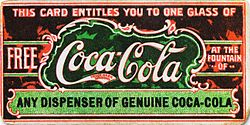
(Photo credit: Wikipedia)
Disclosure: Not a lawyer. Don’t play one on the Internet. But I’ve studied the FTC endorsement guidelines. A lot.
Yesterday news broke that the FTC had issued a warning to shoe manufacturer Cole Haan, notifying it that the disclosures used by consumers in its Wandering Sole contest on Pinterest were not sufficiently clear as to the potential material connection between contest entrants and the company. Said the letter (as quoted in MediaPost):
“We do not believe that the “#WanderingSole” hashtag adequately communicated the financial incentive — a material connection — between contestants and Cole Haan,” Mary Engle, FTC associate director for advertising practices, said in a letter sent to the retailer’s attorneys on March 20.
This represents an evolution in the FTC’s thinking with regard to disclosure of a sweepstakes or contest entry. In the early days, it did not explicitly require such a disclosure when a blogger mentioned a brand in a post to enter a sweeps or contest. In part, because there was no material relationship between the parties, so there was nothing to disclose. And, for the most part, back then (2010!), in text-based formats like blogs and Twitter, sweeps and contest entries were often disclosed as part of the entry instructions. Hence no confusion. [Facebook only allowed contest entries on pages recently.]
So what has changed? The endorsement guidelines are grounded in two basic concepts:
- is there a material (compensated) relationship between the parties, and
- is there a possibility of consumer confusion about the relationship?
In my opinion, the FTC’s thinking has evolved due to the prevalence of contest and sweepstakes entries, particularly on the highly visual Pinterest, that mimic organic endorsements, and do not have clear disclosure that they are a contest or sweepstakes entry. In other words, that the posting is motivated by a commercial incentive, not an organic interest in the product. Quite simply, all these sweeps and contests were causing too much consumer confusion.
The resolution is pretty simple, and follows the same simple guidelines that normal disclosure does. When possible, use natural language to disclose the relationship (Pinned for the Blah Blah Sweepstakes) and use clear hashtags (#sweepsentry) or @ addressing (@BlahSweepsEntry) to make it crystal clear. Using the hashtag or @ addressing is useful even if you also require a natural language disclosure as it makes it easier to track the entries. IMPORTANT: Make the proper disclosure part of the requirements to enter the sweeps or contest.











